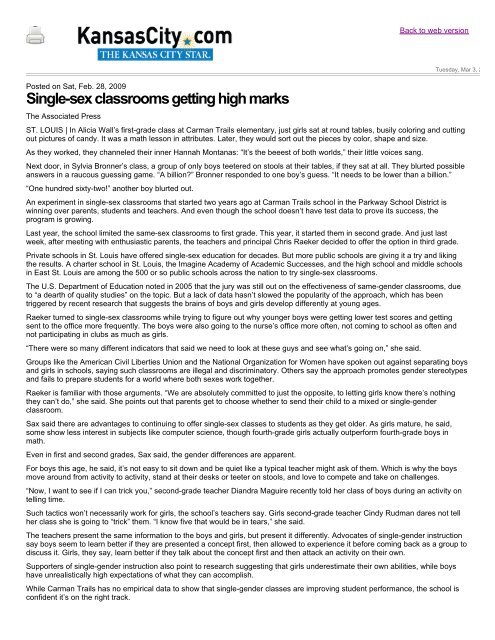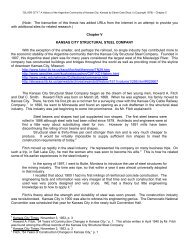March 1 - Kansas City, Kansas Public Schools
March 1 - Kansas City, Kansas Public Schools
March 1 - Kansas City, Kansas Public Schools
- No tags were found...
You also want an ePaper? Increase the reach of your titles
YUMPU automatically turns print PDFs into web optimized ePapers that Google loves.
Back to web versionPosted on Sat, Feb. 28, 2009Single-sex classrooms getting high marksTuesday, Mar 3, 2The Associated PressST. LOUIS | In Alicia Wall’s first-grade class at Carman Trails elementary, just girls sat at round tables, busily coloring and cuttingout pictures of candy. It was a math lesson in attributes. Later, they would sort out the pieces by color, shape and size.As they worked, they channeled their inner Hannah Montanas: “It’s the beeest of both worlds,” their little voices sang.Next door, in Sylvia Bronner’s class, a group of only boys teetered on stools at their tables, if they sat at all. They blurted possibleanswers in a raucous guessing game. “A billion?” Bronner responded to one boy’s guess. “It needs to be lower than a billion.”“One hundred sixty-two!” another boy blurted out.An experiment in single-sex classrooms that started two years ago at Carman Trails school in the Parkway School District iswinning over parents, students and teachers. And even though the school doesn’t have test data to prove its success, theprogram is growing.Last year, the school limited the same-sex classrooms to first grade. This year, it started them in second grade. And just lastweek, after meeting with enthusiastic parents, the teachers and principal Chris Raeker decided to offer the option in third grade.Private schools in St. Louis have offered single-sex education for decades. But more public schools are giving it a try and likingthe results. A charter school in St. Louis, the Imagine Academy of Academic Successes, and the high school and middle schoolsin East St. Louis are among the 500 or so public schools across the nation to try single-sex classrooms.The U.S. Department of Education noted in 2005 that the jury was still out on the effectiveness of same-gender classrooms, dueto “a dearth of quality studies” on the topic. But a lack of data hasn’t slowed the popularity of the approach, which has beentriggered by recent research that suggests the brains of boys and girls develop differently at young ages.Raeker turned to single-sex classrooms while trying to figure out why younger boys were getting lower test scores and gettingsent to the office more frequently. The boys were also going to the nurse’s office more often, not coming to school as often andnot participating in clubs as much as girls.“There were so many different indicators that said we need to look at these guys and see what’s going on,” she said.Groups like the American Civil Liberties Union and the National Organization for Women have spoken out against separating boysand girls in schools, saying such classrooms are illegal and discriminatory. Others say the approach promotes gender stereotypesand fails to prepare students for a world where both sexes work together.Raeker is familiar with those arguments. “We are absolutely committed to just the opposite, to letting girls know there’s nothingthey can’t do,” she said. She points out that parents get to choose whether to send their child to a mixed or single-genderclassroom.Sax said there are advantages to continuing to offer single-sex classes to students as they get older. As girls mature, he said,some show less interest in subjects like computer science, though fourth-grade girls actually outperform fourth-grade boys inmath.Even in first and second grades, Sax said, the gender differences are apparent.For boys this age, he said, it’s not easy to sit down and be quiet like a typical teacher might ask of them. Which is why the boysmove around from activity to activity, stand at their desks or teeter on stools, and love to compete and take on challenges.“Now, I want to see if I can trick you,” second-grade teacher Diandra Maguire recently told her class of boys during an activity ontelling time.Such tactics won’t necessarily work for girls, the school’s teachers say. Girls second-grade teacher Cindy Rudman dares not tellher class she is going to “trick” them. “I know five that would be in tears,” she said.The teachers present the same information to the boys and girls, but present it differently. Advocates of single-gender instructionsay boys seem to learn better if they are presented a concept first, then allowed to experience it before coming back as a group todiscuss it. Girls, they say, learn better if they talk about the concept first and then attack an activity on their own.Supporters of single-gender instruction also point to research suggesting that girls underestimate their own abilities, while boyshave unrealistically high expectations of what they can accomplish.While Carman Trails has no empirical data to show that single-gender classes are improving student performance, the school isconfident it’s on the right track.
















